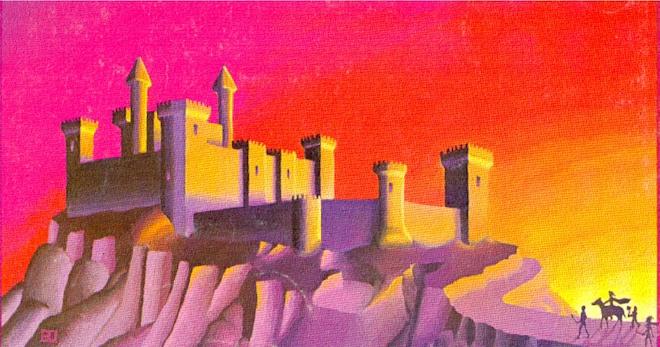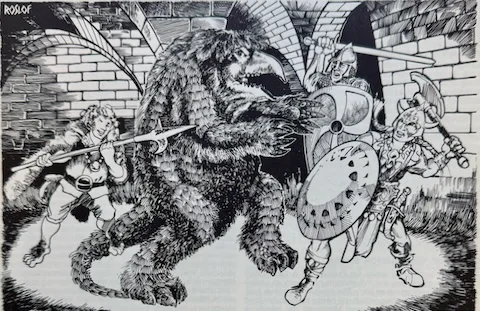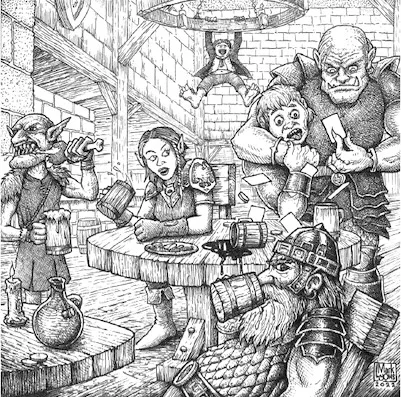The Keep on the Shadowlands

Table of Contents
Why B2? #
Are you looking for the perfect starter module for Shadowdark RPG? Look no further than the venerable B2 - The Keep on the Borderlands. The game’s creator, Kelsey Dionne, says that Shadowdark RPG is a love letter to classic fantasy RPGs. Well, it doesn’t get more classic than Moldvay Basic D&D.
The Keep on the Borderlands, written by Gary Gygax himself, came with the Basic rules and was labeled as a “Special Instructional Module.” It was meant to teach new DMs how to run the game and to teach new players what it meant to play D&D.
Can it do the same for Shadowdark? Yes. Yes it can. In this post, I’ll explain what makes B2 so well suited to Shadowdark and give you some pointers to help you run it for your table.
B2 Passes the Shadowdark Vibe Check 🗹 #
As the title of this post suggests, The Keep on the Borderlands practically oozes the Shadowdark ethos. Shadowdark is suitable for all types of play, but there is no doubt that at its core, it is a dungeon crawler. The first three words of the Shadowdark core rulebook are “They were crawlers…” Well, the Keep on the Borderlands is a dungeon crawl. To a generation of players, it is THE dungeon crawl. The “Shadowdark is any place where danger and darkness hold sway.” It dares fortune seekers to tempt their fates. If that doesn’t describe the Caves of Chaos, I’m not sure what does.

B2 also vibes very well with the Shadowdark rules and mechanics. Not just because Shadowdark has an old school bent to it. Yes, the lower hit points and dialed back character powers generally match well with the Basic D&D modules. But that is just the beginning. Many of Shadowdark’s signature mechanics are ideal for running B2:
-
The focus on light (or the lack thereof) and the torch timer puts the chaos back in the Caves of Chaos - keeping the tension up as players explore. Attacking the light, a signature move for Shadowdark monsters, fits right in with the monster tactics provided in B2.
-
Gear slots, another Shadowdark resource management mechanic, forces players think carefully about what they can bring to the Caves - and how much they can take back to the Keep.
-
Shadowdark’s “always on initiative” is great for new players, because if gives everyone a chance to do something (or at least think about things they could do). This blends perfectly with a “Special Instructional Module” designed to introduce new players to the game.
-
Shadowdark awards XP based on treasure, just as Basic D&D did. That means B2 is already setup to allow characters to advance as they explore the Caves. Shadowdark also awards XP for secrets and clever thinking. Opportunities for both abound in the Caves and the Keep

Shadowdark Works for Old School Campaigns #
People ask me if you can run a campaign using Shadowdark. My answer is always “absolutely.” Dungeon crawling is the beginning of Shadowdark, but it’s not the end. Here again, B2 provides a great setting for exploring these aspects of Shadowdark.
Take Carousing. In Shadowdark, carousing is a downtime exercise that lets players spend some of their hard won coin to gain additional XP or other things - like NPC contacts and magic items. Carousing turns the Keep on the Borderlands into more than just a place to buy supplies. GM’s could use carousing to distribute some of B2’s famous rumors (Bree-yark!), turn the tavern into an exciting place to visit, give the characters contacts (or enemies) in the guard or one of the guilds, or otherwise add flavor to the adventure.
Shadowdark’s rules also describe how characters can learn during downtime, something the GM can use to foster player interaction with the NPCs in the Keep. GM’s can weave in other Shadowdark fun as well - rumor has it that a game of “Wizards and Thieves” can be had at the tavern…
Another campaign feature common to Shadowdark and B2 is outdoor adventuring. If played as designed, it takes more than a day for the players to travel to and from the Caves. While in the wild, they may encounter lizard men, raiders, and a Mad Hermit - as well as wondering monsters and other dangers. B2 sets the scene for this, but then directs players to the Expert set for rules on Wilderness adventures. Shadowdark to the rescue! Shadowdark gives the GM succinct and effective rules for managing overland travel in the game.
Finally, B2 is a deliberately unfinished module. GM’s are encouraged to design their own floor plans for the buildings in the Keep. And, of course, there is the infamous “Cave of the Unknown” just waiting to be designed. Shadowdark contains oodles of tables and advice that can help a GM fill out those parts of the module. Pro tip: when it comes to drawing your floor plans and maps, be sure to check out the Filk Silverpen’s Guides at http://www.jpcoovert.com/.
“Converting” B2 for Shadowdark #
Converting modules from one system to another can seem daunting. There is an entire product line based on converting old school modules to 5E. Fortunately, B2 requires no real conversion effort to play with Shadowdark, which is another reason they are a great match. That’s not to say that there aren’t some conversions necessary. What I mean is that you don’t need to re-write the module or write up a giant conversion guide before you play. To help you and your players experience both Shadowdark and this classic module, I offer some conversion tips.
As noted above, B2 is a Basic D&D module. That means upside down armor class, THAC0, weird saving throws, and lower hit points. We do need to account for these differences, but it’s not difficult to do on the fly. I may explain some noodley background stuff below, but it won’t be necessary to use it during game play.
Hit Points 🩹 #
This one is easy. Don’t worry about hit points. Basic D&D hit points and Shadowdark hit points may not track exactly, but they are in the same ballpark. I’d play with all the hit points as written in the module, unless you think they need tweaking here and there. Remember, in Shadowdark, the Only Rule is that you (the GM) make the rules.
Saving Throws 🎲🎲 #
Shadowdark doesn’t have them. If you see a saving throw, just substitute a reasonable ability check. For example, a Save vs. Poison becomes a CON check and a Save vs. Breath Weapon becomes a DEX check. Easy peasy.
Armor Class 🛡️ #
For Monster/NPC armor class, just subtract the AC in the module text from 20 and that is the AC for Shadowdark. For example, the Bailiff is listed with an AC of 1, which equates to an AC of 19 in Shadowdark. A monster with an AC of 5 in the module would have an AC of 15 in the game. Don’t fear negative AC, just do the math. An AC of -3 in the module would be an AC of 23 in the game. Is that high? Yep. But this is an introductory module for low level players. They are not supposed to attack the Castellan and he’s supposed to be a badass. The early modules were designed to discourage murder-hoboism.
For your players: leave their AC alone. It will balance fine. In Basic D&D, base AC was 9 minus DEX mod (DEX mod ranged from -3 to +3). In Shadowdark, base AC is 10 plus DEX mod (DEX mod ranges from -4 to +4). The Basic D&D AC, converted, is 11 +/-3 and Shadowark is 10 +/-4. Close enough for government work.
Skill Checks 🤹 #
Shadowdark doesn’t have them. Sometimes the module lists a percentage chance of success for something. You could do math here, but I say make it easy. Use the Shadowdark guidelines for assigning a difficulty class to the relevant ability score check and move on.
Monsters 🧌 #
You have two choices here:
-
Grab the equivalent SD monster stats from the rulebook and use those. The stats will be close enough. Take Goblins for example. Page 16 of B2 lists goblin stats as AC6, HD1, 3 hp, 1 attack for d6. This would translate to AC 14 and +1 to hit (see below for the to hit translation if you want to go that route). The Shadowdark stats for goblins are AC 11, 5 hp, 1 attack for 1d4. The B2 goblins do a little more damage, but are harder to hit and have less HP. The Shadowdark goblins deal less damage and are easier to hit, but can take more damage.
-
You can convert the B2 monster stats to Shadowdark. To do this, hit points, number of attacks, and special to hit bonuses stay the same as listed. The AC converts as above. The normal to hit bonus is figured differently and is discussed below.
To Hit Bonus: I’ll spare you the THAC0 analysis and just give you the quick conversions for monsters and NPCs. Of course, if you use the Shadowdark monster stats, you don’t need to do this conversion for monsters.
-
For a B2 monster, take the listed Hit Dice number (rounding up for fractional hit dice above 1) and add one to it to determine the to hit bonus. For example, a monster with 3 hit dice gets a +4 to hit before any magical or other bonuses are added. If a monster has less than 1 hit die, its to hit bonus is +1. (This conversion isn’t tough to do, but my preference is to just look up the Shadowdark monster stats. Besides, everyone knows that stingbats are cooler than stirges!
-
For NPCs, unless a level is specified, just roll a d20 and add the modifier if noted (e.g., a magic or other bonus). If a level is specified, the bonus is +1 for 1st to 3rd level and +2 for 4th level and up. For example, the Captain of the Guard is a level 3 fighter, so his bonus is +1.
Overland Travel 🥾 #
As discussed above, Shadowdark has overland travel rules. Like all outdoor rules, they are hex based. So, of course, the outdoor map in B2 is square based. And, of course, the scales don’t match: Shadowark assumes the fairly standard 6 mile hex and the B2 squares are 100 yards. That’s roughly 106 squares per hex, which makes most of the B2 wilderness map fit in a single hex. To keep things easy, I’d use the travel times listed in B2 (3 squares per hour) and allow no more than 8 hours of travel per day. Check for random encounters per the Shadowdark rules.
Who are all these people? 🤔 #
Sometimes the biggest challenge to converting classic modules is that so many little details are missing. B2 is no different. Not to worry, this just provides another opportunity for Shadowdark to shine and make you look like a master GM. The random NPC tables give you everything you need to flesh out the nameless NPCs inhabiting the Keep. Who else is at the store when the PCs visit? There’s a table for that. What’s the name of the tavern? There’s a table for that. Need a rival party to motivate the players? There’s a table for that.
Conclusion #
That’s it for now. My goal was to inspire you to take your Crawlers through the Keep on the Borderlands and give you some tools to make that easy and fun. Happy crawling - don’t drop your torch!